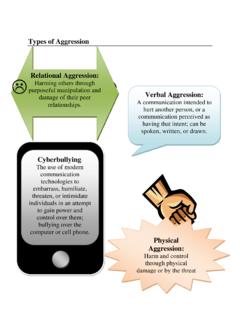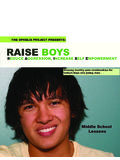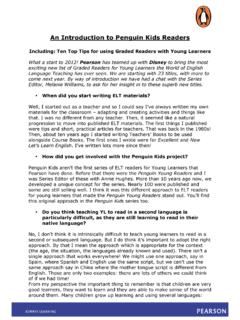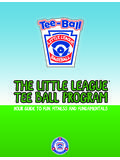Transcription of Kids Helping Kids,09.14.07,FINAL - Ophelia Project
1 kids Helping KidsElementary CurriculumGrades 4-5 kids Helping KidsKids Helping kids instills normative beliefs in fourth and fifth grade students that foster cooperation, respect and effective conflict resolution. kids will gain an understanding of relational aggression, develop pro-social behaviors and help create a safe social climate. kids Helping kids also promotes awareness of relational aggression among parents, educators and 1 What Does It Mean to Be a Friend?Lesson 2 How Do We Treat our Classmates and Friends?Lesson 3 Stop, Look and ListenLesson 4 Relational Aggression HurtsLesson 5 Look InsideLesson 6 Resist Relational AggressionLesson 7 Just Do It, The Right ThingLesson 8 Make a DifferenceLesson 9 Change the School CultureLesson 10 Reflecting on Relational Aggression kids Helping KidsKids Helping KidsKids Helping KidsKids Helping kids 2006 The Ophelia Project kids Helping kids - 2 Table of Contents Introduction.
2 4 Before You 8 Objectives ..8 Pro-Social Norms ..8 Safe Learning Climate Curriculum Implementation ..9 10 Lesson 10 Pre and Post Measures .. 11 Journal of Reflections .. 11 Extension 12 Materials Supplemental Materials .. 13 Bulletin Board 13 Lesson 13 Essential Questions ..16 kids Helping kids Questionnaire ..17 What Does It Mean to Be a Friend?..18 Lesson 1 - Classmates and Friends ..19 Lesson 2 - How Do We Treat our Classmates and Friends? ..22 Lesson 3 - Stop, Look and Listen: What is it? Who does it hurt? ..26 Helping Others 30 You Make a World of Difference Buttons .. 31 Reflection Activity 32 Lesson 4 - Relational Aggression Hurts: Each of Us Plays a Role ..33 Reflection Activity 37 Relational Aggression Story Cards .. 38 Lesson 5 - Look Inside: What s Really Going On?..40 Essential Question 5.
3 44 Reflection Activity 45 Lesson 6 - Resist RA: What can you do to be part of the solution? ..46 The ABC s of Problem Solving .. 50 Reflection Activity 51 Role Play Scenarios .. 52 2006 The Ophelia Project kids Helping kids - 3 Lesson 7 - Just Do It, The Right Thing - What are your options?..54 Using "I Messages".. 61 Solution Lesson 8 - Make a Difference - What do they really feel?..63 Words that Describe 67 Lesson 9 - Change the School Lesson 10 - Reflecting on Relational kids Helping kids Questionnaire .. 72 Reflection Activity 73 Sample Parent Letter .. 74 Recommended Resources ..75 Preschool and Elementary School 75 Elementary and Middle School 78 Books for 79 Web Site Resources for Adults .. 80 2006 The Ophelia Project kids Helping kids - 4 Introduction kids Helping kids culminates in an awareness building campaign developed by students.
4 In schools today, aggression among peers has become the norm. Not surprisingly, lessons that teach friendship building are a rarity in most curricula. When aggression occurs, it not only impacts children s social and emotional well-being; it also makes it difficult for children to focus on academic learning. As adults who work with children, we can appreciate the importance of nurturing, caring friendships that act as excellent support systems in our lives. We therefore understand how important friendships are in the lives of the children we teach. Elementary school is a crucial time in a child s life, and it is imperative that students learn normative beliefs that foster cooperation, respect and effective conflict resolution. The great need for this kind of education is a key motivating factor of The Ophelia Project , and the force behind the creation of this curriculum, which promotes awareness of peer aggression among parents, educators, administrators and most importantly, children.
5 This curriculum targets elementary grades four and/or five. The focus is to: Define peer aggression with a special emphasis on relational aggression Help students share personal experiences, when appropriate Identify the three major roles in peer aggression: aggressor, target and bystander or kid in the middle Create a safe social climate by teaching children pro-social behaviors The goal in implementing this curriculum is that students will be empowered to begin to deal with aggression and feel that their classroom is a socially and emotionally safe environment in which to learn. Contributors: The following people contributed to the creating of kids Helping kids , copyright 2006: Karen Fortebraccio, Iroquois School, Iroquois, PA Nancy Nevel, Intermediate Unit, Erie, PA Sally Gornell, Traci School, Millcreek, PA 2006 The Ophelia Project kids Helping kids - 5 What is relational aggression?
6 Aggression and victimization among children and adolescents is considered to be one of the most serious problems plaguing youth today. Although estimates vary, most studies indicate that approximately 10% to 15% of children are severely bullied by peers; many more children experience victimization at a lower, but nonetheless painful, level of severity. Relational aggression is behavior that is intended to hurt someone by harming his or her relationships with others. This kind of behavior is often covert and subtler than physical bullying, and requires careful observation by both students and teachers. The way in which students use their relationships to hurt one another through aggression may include all or some of the following behaviors: Exclusion Building alliances Teasing and put-downs Spreading rumors and gossip Covert physical aggression Cyberbullying Overt aggression is defined as physical bullying or other harassment that can be easily seen by others.
7 The bully physically or verbally attacks a classmate who may or may not be part of his/her social circle. Overt aggression is often easier for others to identify and includes: Any form of physical aggression, including threats Name calling based on race, religion, gender or sexual orientation Verbal abuse including put-downs and sexual harassment Taunting Peer aggression can happen in different ways it can be either overt, covert or a combination of the two. Until recently, it was widely accepted that boys were more aggressive than girls and that boys were more likely than girls to be victims of 2006 The Ophelia Project kids Helping kids - 6 aggression. As a consequence of this, the majority of intervention efforts in schools have been targeted at modifying boys aggressive behaviors.
8 However, researchers have recently shown that girls engage in just as much aggression as boys. Importantly, the expression of aggression among girls is different from that of boys. Both boys and girls use verbal aggression, such as verbal insults, but the nature and content of verbal assaults are likely to differ for boys and girls. Whereas boys are more likely to engage in physical forms of aggression, girls are more likely to use more covert forms of behavior that harms others by damaging or manipulating their social relationships through relational aggression (Crick & Grotpeter, 1995). All forms of peer aggression are hurtful and harmful. Too often peer aggression is written off as boys will be boys or that s how girls act. Research shows, however, that peer aggression has a negative impact on self-esteem, one s ability to form and create friendships and one s sense of belonging.
9 All of these, in turn, have a significant impact on a student s academic life. How can this curriculum help you address relational aggression? Research has shown that children begin to use relational aggression during the preschool years, and even at this young age, girls appear to engage in relational aggression more frequently than boys. Moreover, relational aggression is as powerful and frequent a social behavior as physical aggression through the middle school years. That is, some children consistently use relational aggression in their social interactions, despite changes in classroom environments from year to year. In order to address aggression s complex and deep-rooted influence over middle school students, it is critical for parents, teachers and the students themselves to be proactive.
10 Rather than reacting to incidents of peer aggression after they occur, students and teachers can work to create a school culture that values cooperation, true appreciation of diversity, tolerance and friendship. Many schools today know that peer aggression is a serious problem, but only a few have the vision, resolve, leadership and support to work towards systemic change. Schools know how to promote the beliefs, norms and behaviors needed for students to learn academically. The same kind of skills and focus can be applied to changing social climate in classrooms .. within every school where peer aggression is a problem there is a set of social norms that allows aggression to take place. Once we recognize what is actually happening, we can begin the long-term process of changing children s normative beliefs and social behaviors.
















